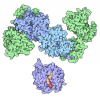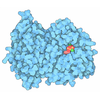+ データを開く
データを開く
- 基本情報
基本情報
| 登録情報 | データベース: PDB / ID: 9jjf | |||||||||
|---|---|---|---|---|---|---|---|---|---|---|
| タイトル | Nematostella vectensis TRPM2 protomer in complex with ADPRP/Ca2+ | |||||||||
 要素 要素 | Transient receptor potential cation channel subfamily M member-like 2 | |||||||||
 キーワード キーワード | MEMBRANE PROTEIN / Nematostella vectensis / TRPM2 / ADPRP / Ca2+ | |||||||||
| 機能・相同性 |  機能・相同性情報 機能・相同性情報ADP-ribose diphosphatase activity / ligand-gated calcium channel activity / ligand-gated sodium channel activity / sodium ion transmembrane transport / calcium ion transmembrane transport / metal ion binding / plasma membrane 類似検索 - 分子機能 | |||||||||
| 生物種 |  Nematostella vectensis (イソギンチャク) Nematostella vectensis (イソギンチャク) | |||||||||
| 手法 | 電子顕微鏡法 / 単粒子再構成法 / クライオ電子顕微鏡法 / 解像度: 2.65 Å | |||||||||
 データ登録者 データ登録者 | Jiang, Y. / Zhang, Z. / Toth, B. / Szollosi, A. / Csanady, L. | |||||||||
| 資金援助 |  中国, 2件 中国, 2件
| |||||||||
 引用 引用 |  ジャーナル: Proc Natl Acad Sci U S A / 年: 2024 ジャーナル: Proc Natl Acad Sci U S A / 年: 2024タイトル: A conserved mechanism couples cytosolic domain movements to pore gating in the TRPM2 channel. 著者: Balázs Tóth / Yuefeng Jiang / Andras Szollosi / Zhe Zhang / László Csanády /   要旨: Transient Receptor Potential Melastatin 2 (TRPM2) cation channels contribute to immunocyte activation, insulin secretion, and central thermoregulation. TRPM2 opens upon binding cytosolic Ca and ADP ...Transient Receptor Potential Melastatin 2 (TRPM2) cation channels contribute to immunocyte activation, insulin secretion, and central thermoregulation. TRPM2 opens upon binding cytosolic Ca and ADP ribose (ADPR). We present here the 2.5 Å cryo-electronmicroscopy structure of TRPM2 from (nvTRPM2) in a lipid nanodisc, complexed with Ca and ADPR-2'-phosphate. Comparison with nvTRPM2 without nucleotide reveals that nucleotide binding-induced movements in the protein's three "core" layers deconvolve into a set of rigid-body rotations conserved from cnidarians to man. By covalently crosslinking engineered cysteine pairs we systematically trap the cytosolic layers in specific conformations and study effects on gate opening/closure. The data show that nucleotide binding in Layer 3 disrupts inhibitory intersubunit interactions, allowing rotation of Layer 2 which in turn expands the gate located in Layer 1. Channels trapped in that "activated" state are no longer nucleotide dependent, but are opened by binding of Ca alone. | |||||||||
| 履歴 |
|
- 構造の表示
構造の表示
| 構造ビューア | 分子:  Molmil Molmil Jmol/JSmol Jmol/JSmol |
|---|
- ダウンロードとリンク
ダウンロードとリンク
- ダウンロード
ダウンロード
| PDBx/mmCIF形式 |  9jjf.cif.gz 9jjf.cif.gz | 193.6 KB | 表示 |  PDBx/mmCIF形式 PDBx/mmCIF形式 |
|---|---|---|---|---|
| PDB形式 |  pdb9jjf.ent.gz pdb9jjf.ent.gz | 142.9 KB | 表示 |  PDB形式 PDB形式 |
| PDBx/mmJSON形式 |  9jjf.json.gz 9jjf.json.gz | ツリー表示 |  PDBx/mmJSON形式 PDBx/mmJSON形式 | |
| その他 |  その他のダウンロード その他のダウンロード |
-検証レポート
| アーカイブディレクトリ |  https://data.pdbj.org/pub/pdb/validation_reports/jj/9jjf https://data.pdbj.org/pub/pdb/validation_reports/jj/9jjf ftp://data.pdbj.org/pub/pdb/validation_reports/jj/9jjf ftp://data.pdbj.org/pub/pdb/validation_reports/jj/9jjf | HTTPS FTP |
|---|
-関連構造データ
| 関連構造データ |  61525MC  9jjeC M: このデータのモデリングに利用したマップデータ C: 同じ文献を引用 ( |
|---|---|
| 類似構造データ | 類似検索 - 機能・相同性  F&H 検索 F&H 検索 |
- リンク
リンク
- 集合体
集合体
| 登録構造単位 | 
|
|---|---|
| 1 |
|
- 要素
要素
| #1: タンパク質 | 分子量: 176663.438 Da / 分子数: 1 / 由来タイプ: 組換発現 由来: (組換発現)  Nematostella vectensis (イソギンチャク) Nematostella vectensis (イソギンチャク)遺伝子: TRPM2, v1g248535 / 発現宿主:  Homo sapiens (ヒト) / 参照: UniProt: A7T1N0 Homo sapiens (ヒト) / 参照: UniProt: A7T1N0 |
|---|---|
| #2: 多糖 | 2-acetamido-2-deoxy-beta-D-glucopyranose-(1-4)-2-acetamido-2-deoxy-beta-D-glucopyranose |
| #3: 化合物 | ChemComp-CA / |
| #4: 化合物 | ChemComp-A2R / [( |
| 研究の焦点であるリガンドがあるか | Y |
| Has protein modification | Y |
-実験情報
-実験
| 実験 | 手法: 電子顕微鏡法 |
|---|---|
| EM実験 | 試料の集合状態: PARTICLE / 3次元再構成法: 単粒子再構成法 |
- 試料調製
試料調製
| 構成要素 | 名称: nvTRPM2 protomer in complex with ADPRP/Ca2+ / タイプ: COMPLEX / Entity ID: #1 / 由来: RECOMBINANT |
|---|---|
| 分子量 | 値: 0.17 MDa / 実験値: YES |
| 由来(天然) | 生物種:  Nematostella vectensis (イソギンチャク) Nematostella vectensis (イソギンチャク) |
| 由来(組換発現) | 生物種:  Homo sapiens (ヒト) Homo sapiens (ヒト) |
| 緩衝液 | pH: 8 |
| 試料 | 濃度: 6 mg/ml / 包埋: NO / シャドウイング: NO / 染色: NO / 凍結: YES |
| 急速凍結 | 凍結剤: ETHANE |
- 電子顕微鏡撮影
電子顕微鏡撮影
| 実験機器 |  モデル: Titan Krios / 画像提供: FEI Company |
|---|---|
| 顕微鏡 | モデル: FEI TITAN KRIOS |
| 電子銃 | 電子線源:  FIELD EMISSION GUN / 加速電圧: 300 kV / 照射モード: FLOOD BEAM FIELD EMISSION GUN / 加速電圧: 300 kV / 照射モード: FLOOD BEAM |
| 電子レンズ | モード: BRIGHT FIELD / 最大 デフォーカス(公称値): 2200 nm / 最小 デフォーカス(公称値): 1000 nm |
| 撮影 | 電子線照射量: 60 e/Å2 / フィルム・検出器のモデル: GATAN K3 (6k x 4k) |
- 解析
解析
| EMソフトウェア | 名称: PHENIX / バージョン: 1.21_5207: / カテゴリ: モデル精密化 | ||||||||||||||||||||||||
|---|---|---|---|---|---|---|---|---|---|---|---|---|---|---|---|---|---|---|---|---|---|---|---|---|---|
| CTF補正 | タイプ: NONE | ||||||||||||||||||||||||
| 3次元再構成 | 解像度: 2.65 Å / 解像度の算出法: FSC 0.143 CUT-OFF / 粒子像の数: 474307 / 対称性のタイプ: POINT | ||||||||||||||||||||||||
| 拘束条件 |
|
 ムービー
ムービー コントローラー
コントローラー




 PDBj
PDBj





